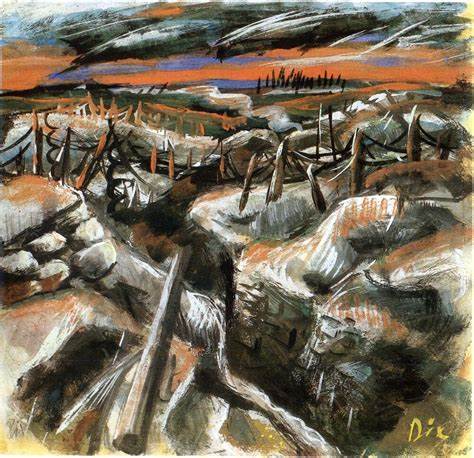And so, when Europe went to war in July in 1914,few ordinary people questioned the prevailing view of Western civilisation as sophisticated, rational and humane.
于是 当欧洲在1914年7月开战的时候 普通人鲜少质疑 西方文明是成熟 理性且人性的这一普遍观点
Yet the horror that was unleashed by new weapons that could slaughter human beings on an unprecedented scale
而那些能够致使人类遭受 史无前例规模毁灭的新武器所造成的恐慌
was a product of the same Industrial Revolution that had forged the railways and built the Eiffel Tower.
和铁路与埃菲尔铁塔 却都是同一场工业革命的产物

Now it seemed Europeans were reduced to the same irrational barbarism...
似乎欧洲人已经堕落成 同样的无理野蛮状态了
..that they'd convinced themselves was the hallmark of other, supposedly primitive, peoples.
而他们曾确信这种状态仅仅是其他那些 所谓原始民族才具有的特质
In the German trenches of the First World War was an artist who perhaps more than any other created a graphic visual record of the new barbarism.
在第一次世界大战的德军战壕中 出现了一位或许比其他任何人都更深刻地 用画作对这一新野蛮状态进行记录的艺术家
Otto Dix was one of the millions of young European men who enthusiastically rushed to enlist at the outbreak of fighting in 1914,
1914年一战爆发时 奥托·迪克斯是 数百万名热忱地应征入伍的欧洲男青年中的其中一位
and he went on to spend three years in the mud and the slime of the trenches,serving on both the Western and the Eastern fronts.
他随后又继续在战壕的烂泥浑水中待了三年时间 在西线和东线都参过战
At one point, he served in a machine gun unit,wielding the ultimate industrial weapon,the literal fusion of the gun and the machine.
有一段时间 他在一支机枪部队里服役 使用的是终极工业武器 名副其实的枪与机器的融合
And throughout all of this,Otto Dix produced sketches, hundreds of them,that graphically recorded what these new weapons did to the flesh and the bone of his doomed generation.
在整个服役期间 奥托·迪克斯创作了数百幅作品 它们以图画的形式记录了这些新型武器对他这不幸的一代人造成了哪些深入骨髓的伤害
Dix drew the broken faces, the mud and the misery.
迪克斯描绘了那些破损的脸庞 污泥和痛苦
He chronicled how industrial warfare had transformed the soldier from warrior to victim.
他记录下了工业战争是如何将一位士兵从勇士转变成受害者的
It is perhaps fitting that it was a German artist who most clearly captured the horror of industrial warfare.
或许 也只有德国艺术家才能最清晰地记录工业战争的可怕












